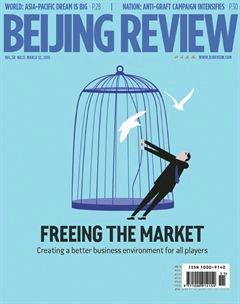Market Dynamism
2015-05-21
Market Dynamism
In the process of developing and nurturing its economic system, the reorientation of governmental functions toward the market represents a fundamental strategy of the Chinese Government.
Since the scheme for comprehensively bolstering reforms was first put forward in November 2013, a series of measures have been introduced: the streamlining of government administration, the devolution of power to lower levels, and the lowering or outright removal of the thresholds for investment.
Over the past year, these reforms have greatly furthered China’s economic transformation and upgrade. The environment for private and foreign capital has improved immeasurably.
Although the strides recently taken have doubtlessly been impressive, they still have not gone sufficiently far. Nothing less than the wholesale dismantling of a status quo in which state capital enjoys a position of privilege in economic activities represents the key to securing a decisive role for the market in the distribution of resources. Therefore, further reform of its state-owned enterprises (SOEs) is systemic to enabling China to better balance the relationship between the government and the market.
China is now launching yet another round of reforms on SOEs. Detailed reform schemes have been submitted to the Central Government, which are expected to be formally announced after this March’s annual NPC and CPPCC National Committee sessions.
This latest reform plan will most likely center on measures long anticipated by the market such as the overhaul of mixed ownership and the proliferation of share ownership among SOE employees. The purpose is to retain state-owned capital’s controlling interest, while reducing its proportion in the enterprises’ overall capital composition.
This will be the third large-scale reform that China has launched on its SOEs, and historic breakthroughs are expected to arise from it. Compared to the first reform in the 1990s, primarily intended to replace the model of a planned economy with a modern corporate system, and the second reform in the early years of this century, designed to break up the monopoly held by SOEs in the domestic market, the recent set of reforms mean to furnish state-owned and non-state-owned capital with a platform upon which they can cooperate and compete equitably with one another.
Meanwhile, the government hopes to facilitate a fresh injection of private capital into SOEs through reforms on the mixed ownership system. This will enable the state-owned and private sectors to enjoy the “best of both worlds,” with regard to human and financial capital and play to each other’s strengths. The influx of private capital will serve to improve SOEs’business strategies, and, hopefully, private expertise will help minimize strategic mistakes made at SOEs’ managerial level and consequently limit the damage done to shareholders’ interests.
